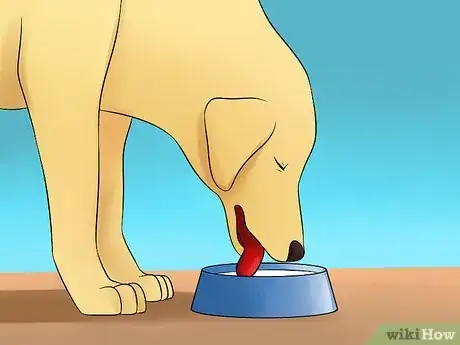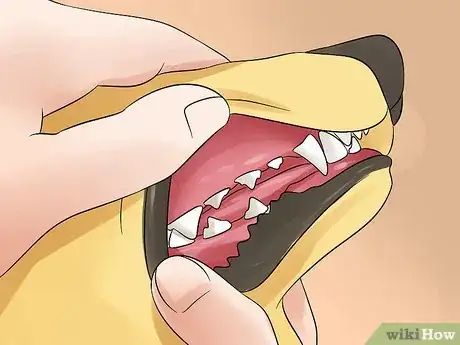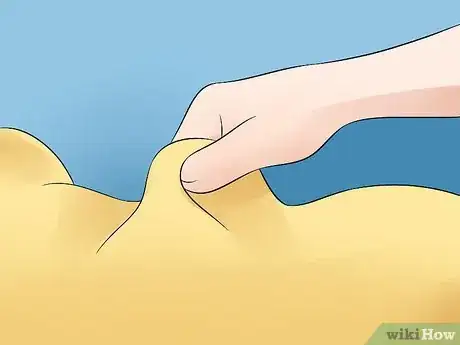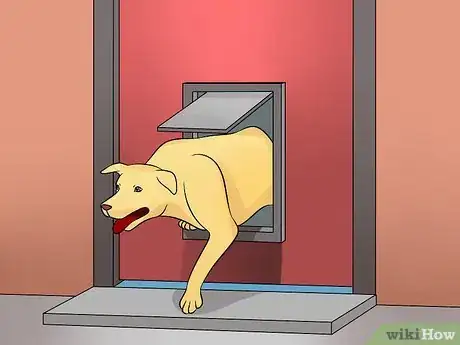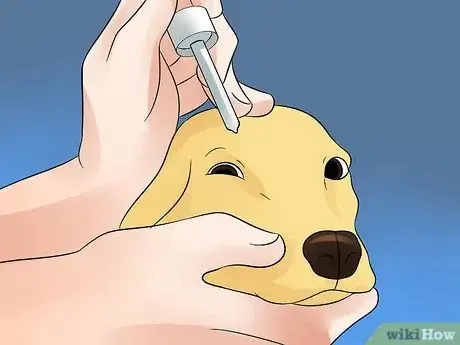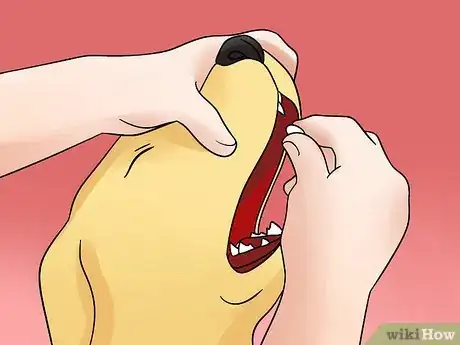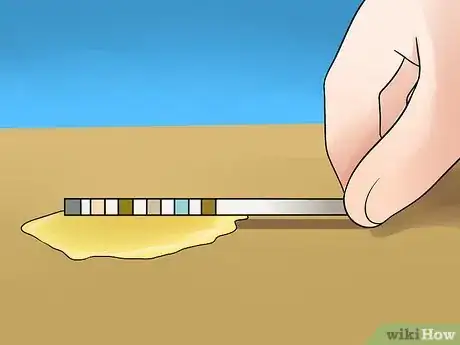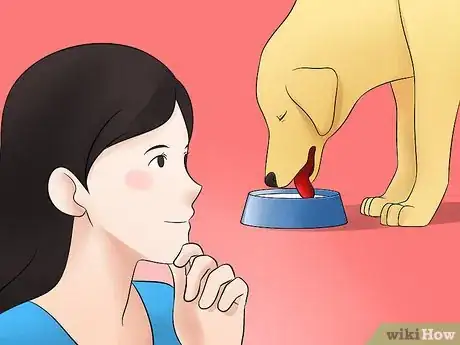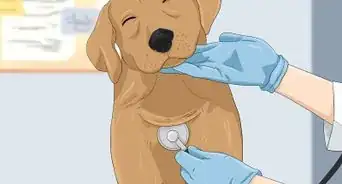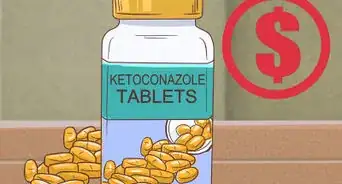X
wikiHow is a “wiki,” similar to Wikipedia, which means that many of our articles are co-written by multiple authors. To create this article, volunteer authors worked to edit and improve it over time.
This article has been viewed 28,382 times.
Learn more...
Diabetes insipidus is a rare disease that affects young dogs that are less than a year old. The condition causes a dog’s body to become unable to concentrate urine, so the dog has a hard time retaining fluid. If your dog has diabetes insipidus, it is very important that you can spot the signs of dehydration, which are discussed in Method 1.
Steps
Method 1
Method 1 of 3:
Spotting the Warning Signs of Dehydration
-
1Understand why it is important to check for dehydration. A dog with diabetes insipidus who is denied water will initially be agitated and restless, as he seeks water but can't find any. As he becomes dehydrated there are relatively few warning signs, unless you specifically look for things such as dry gums and test his scruff for hydration.
- Unfortunately, if the dehydration is undetected the blood supply to major organs will be reduced and those organs (of which the kidneys are especially sensitive) will go into failure. The first signs of this could be vomiting and collapse.
-
2Lift the dog's lip and touch his gums to check for dehydration. There should be moisture present; if the gums are dry this could point to early dehydration.Advertisement
-
3Use the scruff method. You can also use your dog’s skin as a way to check for dehydration. Lift the scuff of skin located in between his shoulders; lift it away from his body and then release it. A well hydrated dog’s skin will fall back into place immediately.
- A dog who is dehydrated will have skin that “tents”, which means that after you release it, it stays peaked and very slowly returns to its original position.
Advertisement
Method 2
Method 2 of 3:
Treating Diabetes Insipidus
-
1Troubleshoot your dog’s need to urinate frequently. A dog with diabetes insipidus pretty much needs constant access to an outside area. Installing a doggie door is a good way to handle this.[1]
- Another might be the canine equivalent of a cat-litter box, perhaps utilizing the large type of tray used by garage's to collect oil drips from beneath cars.
-
2Get your dog a prescription for synthetic ADH - DDAVP. The synthetic version of ADH is called desmopressin, or DDAVP. This is available only in liquid form and is supplied in a dropper bottle. You will have to place the drops either in your dog’s nostril or eye. Although this sounds a bizarre way to give your dog medication, the DDAVP is absorbed well through these openings, and can be quickly absorbed into the bloodstream.[2]
- In addition to this, oral forms don’t work because the medication gets destroyed by the digestive tract.
- The dose is 2 to 4 drops twice a day into the eye or nose. The effect plateaus at around 4 drops, and increasing the dose further has not additional benefit.[3]
- Sadly, even treatment with DDAVP does not reduce the concentration of urine your dog produces. The aim of treatment is to decrease the amount of water lost in the urine, so that your dog's drinking is manageable and your dog does not constantly have urinary accidents.
-
3Give your dog Chlorothiazide. Ironically, chlorothiazide belongs to a family of drugs called diuretics (these are drugs which encourage water loss from the body). The mode of action in diabetes insipidus is to cause sodium loss from the body (one of the actions that a diuretic has), which stimulates the body's tissue to reclaim fluid from the blood (instead of the kidney filtering water and holding onto it).
- This drug does not make the urine a normal concentration, but can make it approximately 50% more concentrated than without treatment.[4] While this is not perfect, this can make an appreciable difference in the amount of water the dog drinks and consequently urinates out. In turn this helps with house-soiling problems, if the dog does not need to go out to pass water quite so often.
- The dose is 20 to 40 mg/kg given by mouth twice a day. This is available as a tablet for humans, in 250 mg and 500 mg strengths. Thus a 10 kg dog could safely be given a 250 mg tablet twice daily.[5]
-
4Monitor your dog for complications. Because the urine is dilute, it lacks the normal disinfectant properties that help keep bacteria in check, and an important part of treating diabetes insipidus is to monitor for evidence of urinary tract infections. Even dogs receiving treatment are not able to fully concentrate their urine and are therefore more likely to acquire bladder infections.[6]
- Have your vet perform a dipstick test once a month to look for signs in the blood that could indicate a low grade infection. Every three months, a urine sample should be sent for culture, to try to identify any bugs that are surviving at a low concentration but are not causing overt signs of infection.
- If is important to identify and treat urinary infections because the bacteria may track from the bladder up the ureter (the tubes connecting the bladder to the kidney) and set up a kidney infection.
Advertisement
Method 3
Method 3 of 3:
Understanding Diabetes Insipidus
-
1Be aware that this is not the more common form of diabetes. Despite the name "diabetes", this condition is different from the better known and much more common diabetes mellitus (sugar diabetes). However, what the two conditions do have in common is that dogs drink excessive amounts of water and pass large volumes of urine.
-
2Consider the implications of diabetes insipidus. While diabetes insipidus in itself is not a painful condition, the main problem is your dog's constant need to drink. It takes a special sort of owner to cope with a dog's constant demand for water and then to bring the dog outside to urinate. Indeed, because the signs start in young life, affected dogs can be difficult, if not impossible to housebreak, and many of these dogs end up being euthanized because of it. However, it is important to keep in mind that just because your dog takes a little more work, does not mean that you should love him any less.
- Untreated, even a house broken dog may have a full bladder that leaks in her sleep. Potentially this could cause sores and skin infections.
-
3Consider the two forms of this disease. To appreciate the problems of treating diabetes insipidus it helps to understand what drives the condition. There are two forms of this disease: nephrogenic (kidney based) and central (brain based.)[7]
- Nephrogenic diabetes insipidus is a problem that is present at birth. The kidney does not have the ability to recognize the antidiuretic hormone (ADH) which is released when the body needs to conserve water. Thus, at times when your dog is thirsty and no drinking water is available, the body continues to lose water through urine, rather than reclaiming water, which produces concentrated urine.
- Central diabetes insipidus results from a gland in the brain failing to produce ADH. This deficiency denies the kidney the signal it needs to concentrate urine.
- Unfortunately, it is very difficult to distinguish the two types of diabetes insipidus. The symptoms for both forms are identical and indeed, even with sophisticated imaging such as an MRI scan, unless physical damage to the brain has caused a loss of ADH production, it is difficult to distinguish the two.
Advertisement
Expert Q&A
-
QuestionDo you have any tips on how to get your dog to take oral medication?
 Sophie AmphlettSophie Amphlett is a Professional Dog Trainer and Service Dog Coach with over five years of experience. Sophie graduated from CATCH Canine Trainers Academy’s Master Course with Distinction in 2016. She is also a Certified Trick Dog Instructor (CTDI) and a Certified Fun Scent Games Instructor (DN-FSG1). Sophie serves as a volunteer adoption counselor and dog walker for Adopt-A-Pet as well.
Sophie AmphlettSophie Amphlett is a Professional Dog Trainer and Service Dog Coach with over five years of experience. Sophie graduated from CATCH Canine Trainers Academy’s Master Course with Distinction in 2016. She is also a Certified Trick Dog Instructor (CTDI) and a Certified Fun Scent Games Instructor (DN-FSG1). Sophie serves as a volunteer adoption counselor and dog walker for Adopt-A-Pet as well.
Professional Dog Trainer Assuming the dog’s going to dislike the taste of it, I would put the pill or whatever it is in a slice of meat. You can also buy pill pockets for dogs.
Assuming the dog’s going to dislike the taste of it, I would put the pill or whatever it is in a slice of meat. You can also buy pill pockets for dogs. -
QuestionIs there another medication to treat this disease other than DDAPV? It is very expensive and the dose is so low, my dog is taking about 180 pills a month! Any holistic or natural products available?
 Community AnswerTry it in the nasal spray form. I use it to inject into my dog's tissue like insulin; as it is a higher concentration, he gets a better effect than with any other way.
Community AnswerTry it in the nasal spray form. I use it to inject into my dog's tissue like insulin; as it is a higher concentration, he gets a better effect than with any other way. -
QuestionDoes this condition affect their vision?
 Community AnswerIt can, but that's uncommon. If the only symptom your dog has is bad vision, it's most likely not diabetes. If he or she is exhibiting 3-4 other major symptoms, and the eyes are failing, then it's likely connected.
Community AnswerIt can, but that's uncommon. If the only symptom your dog has is bad vision, it's most likely not diabetes. If he or she is exhibiting 3-4 other major symptoms, and the eyes are failing, then it's likely connected.
Advertisement
References
- ↑ Diabetes Insipidus. Tilley & Smith. The 5-minute Veterinary Consult. Publisher: Williams & Wilkins. pp 514-515
- ↑ Desmopressin. Plumb's Veterinary Drug Handbook. Donald Plumb. Loc 20602
- ↑ Desmopressin. Plumb's Veterinary Drug Handbook. Donald Plumb. Loc 20602
- ↑ Chlorothiazide. Plumb's Veterinary Drug Handbook. Donald Plumb. Loc. 14823
- ↑ Chlorothiazide. Plumb's Veterinary Drug Handbook. Donald Plumb. Loc. 14823
- ↑ Diabetes Insipidus. Tilley & Smith. The 5-minute Veterinary Consult. Publisher: Williams & Wilkins. pp 514-515
- ↑ Diabetes Insipidus. Tilley & Smith. The 5-minute Veterinary Consult. Publisher: Williams & Wilkins. pp 514-515
About This Article
Advertisement
